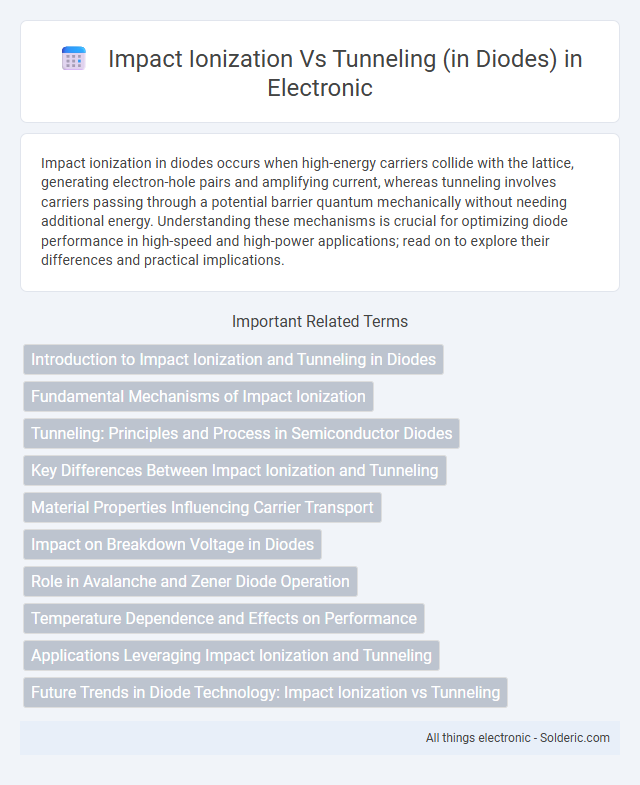Impact ionization in diodes occurs when high-energy carriers collide with the lattice, generating electron-hole pairs and amplifying current, whereas tunneling involves carriers passing through a potential barrier quantum mechanically without needing additional energy. Understanding these mechanisms is crucial for optimizing diode performance in high-speed and high-power applications; read on to explore their differences and practical implications.
Comparison Table
| Feature | Impact Ionization | Tunneling |
|---|---|---|
| Mechanism | High-energy carriers collide, generating electron-hole pairs | Quantum particles pass through energy barrier without crossing it |
| Application | Avalanche photodiodes, avalanche breakdown in diodes | Tunnel diodes, Esaki diodes, Zener diodes breakdown |
| Voltage Range | Usually higher voltage required to initiate ionization | Occurs at lower voltage due to quantum effects |
| Current Behavior | Sharp increase in current after threshold voltage | Negative differential resistance region observed |
| Energy Barrier | Electrons must gain sufficient kinetic energy to ionize | Electrons tunnel through potential barrier |
| Temperature Sensitivity | More sensitive; ionization rates vary with temperature | Less sensitive; quantum tunneling largely temperature-independent |
Introduction to Impact Ionization and Tunneling in Diodes
Impact ionization in diodes occurs when high-energy carriers collide with lattice atoms, generating additional electron-hole pairs that amplify current flow. Tunneling involves carriers passing through a potential barrier due to quantum mechanical effects, enabling current flow even at low voltages. These mechanisms influence diode behavior under high electric fields, affecting breakdown voltage and current conduction characteristics.
Fundamental Mechanisms of Impact Ionization
Impact ionization in diodes occurs when high-energy carriers, accelerated by a strong electric field, collide with the semiconductor lattice, generating electron-hole pairs through energy transfer. This process is a key mechanism in avalanche breakdown, where a single carrier can initiate a chain reaction, multiplying charge carriers exponentially. Unlike tunneling, which involves quantum mechanical barrier penetration at lower electric fields, impact ionization requires carriers to gain sufficient kinetic energy to ionize atoms physically within the depletion region.
Tunneling: Principles and Process in Semiconductor Diodes
Tunneling in semiconductor diodes occurs when electrons quantum mechanically pass through an energy barrier instead of going over it, enabled by a thin depletion region and high electric field. This process, governed by the wave-like nature of electrons, leads to a measurable current even at voltages below the threshold for traditional conduction. Tunneling diodes exploit this principle, resulting in negative differential resistance useful in high-speed switching and microwave applications.
Key Differences Between Impact Ionization and Tunneling
Impact ionization involves high-energy carriers generating electron-hole pairs by colliding with the lattice, leading to avalanche multiplication in diodes, while tunneling allows carriers to pass through a potential barrier quantum mechanically without requiring high energy. Impact ionization typically occurs at higher electric fields and contributes to avalanche breakdown, whereas tunneling dominates at very thin depletion regions with strong electric fields causing band-to-band or trap-assisted tunneling. Your choice between leveraging impact ionization or tunneling depends on diode design goals such as breakdown voltage, switching speed, and leakage current control.
Material Properties Influencing Carrier Transport
Material properties such as bandgap energy and carrier mobility significantly influence impact ionization and tunneling in diodes. A narrower bandgap decreases the energy threshold for impact ionization, enabling easier electron-hole pair generation, while higher carrier mobility enhances the acceleration of carriers, increasing ionization rates. In contrast, tunneling probability is highly dependent on barrier width and effective mass of carriers, with materials exhibiting lower effective mass and thinner barriers favoring quantum tunneling over impact ionization.
Impact on Breakdown Voltage in Diodes
Impact ionization significantly lowers the breakdown voltage in diodes by initiating an avalanche multiplication process when the electric field exceeds a critical threshold, leading to a sudden increase in current. Tunneling, specifically Zener tunneling, occurs at high electric fields in heavily doped diodes and causes breakdown at lower voltages due to quantum mechanical electron passage through the depletion region. The relative dominance of impact ionization versus tunneling depends on doping concentrations and the diode's material properties, directly influencing design choices for controlling breakdown voltage.
Role in Avalanche and Zener Diode Operation
Impact ionization is the primary mechanism in avalanche diodes, where high reverse voltage causes carriers to collide and create a multiplication effect, resulting in avalanche breakdown. Tunneling dominates Zener diode operation at lower breakdown voltages, enabling current flow through quantum mechanical tunneling across a heavily doped p-n junction. Your selection between avalanche and Zener diodes should consider the desired breakdown voltage and the dominant breakdown mechanism for precise circuit protection.
Temperature Dependence and Effects on Performance
Impact ionization in diodes exhibits strong temperature dependence, as increased lattice vibrations at higher temperatures reduce carrier mobility and raise the ionization threshold, leading to decreased multiplication gain and lower breakdown voltage. In contrast, tunneling mechanisms show relatively weak temperature dependence since quantum mechanical tunneling relies primarily on the energy barrier shape and width, which are less affected by thermal fluctuations. Understanding these differences allows you to optimize diode performance by selecting the appropriate conduction mechanism for your operating temperature range, ensuring stable breakdown characteristics and device reliability.
Applications Leveraging Impact Ionization and Tunneling
Impact ionization is crucial in avalanche photodiodes and high-speed transistors, where it enables signal amplification by generating electron-hole pairs under high electric fields. Tunneling is fundamental in tunnel diodes and resonant tunneling diodes, allowing ultra-fast switching and operation at very low voltages through quantum mechanical passage of carriers. Both mechanisms are exploited in advanced semiconductor devices to enhance performance in photodetectors, oscillators, and high-frequency circuits.
Future Trends in Diode Technology: Impact Ionization vs Tunneling
Future trends in diode technology emphasize enhanced energy efficiency and faster switching speeds by optimizing impact ionization and tunneling mechanisms. Advanced materials such as wide-bandgap semiconductors enable greater control over impact ionization rates, improving breakdown voltage and device reliability. Meanwhile, innovations in tunneling diodes, like resonant tunneling structures, focus on lower power consumption and ultra-high-frequency applications, driving the evolution of nanoscale diode components.
Impact ionization vs tunneling (in diodes) Infographic

 solderic.com
solderic.com